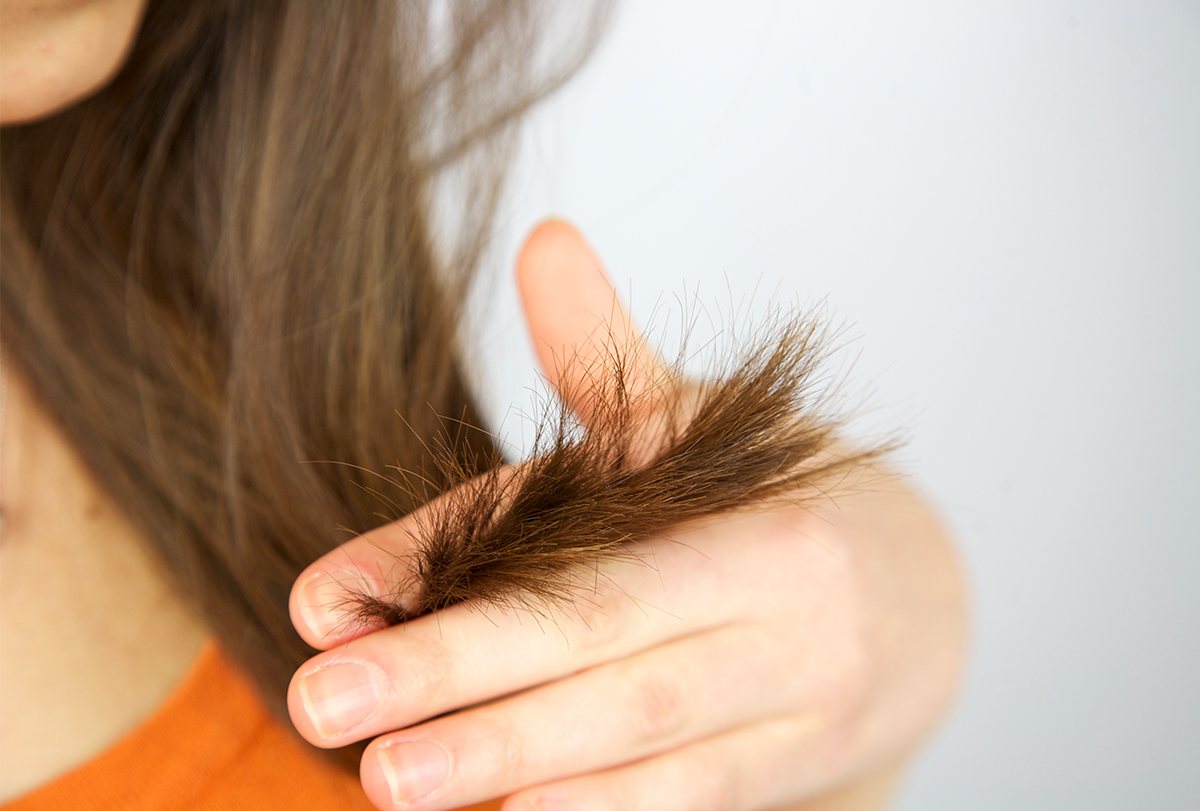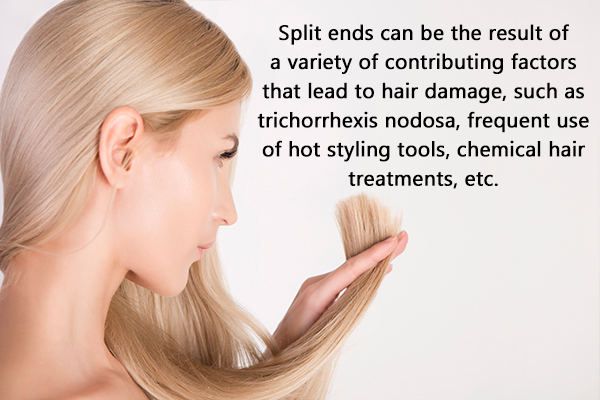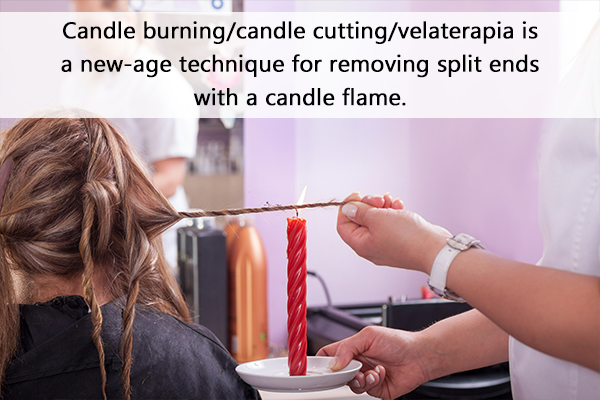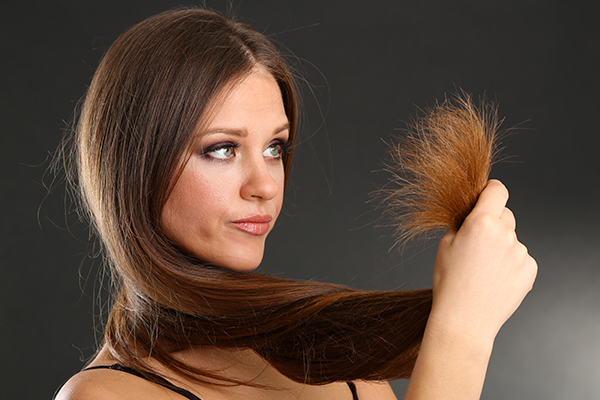In this article:
One of the most common hair-related complaints is split ends, wherein the protective outer layer of the hair becomes worn out and breaks open. Many people assume that the problem of split ends is limited to the hair tips, but this form of hair damage can occur anywhere along the length of the hair.

Long hair has a greater surface area and requires extra care and nourishment, making it more prone to split ends than short hair. Fraying of the hair shaft may begin as superficial damage but can eventually ruin the hair to its core.
So, split ends not only make the hair look drab and unhealthy but can also make it weak and difficult to manage. If left untreated, this kind of hair damage can pave the way for undue hair breakage or hair fall.
Each strand of hair sprouts from a hair follicle in the scalp and extends beneath the scalp skin. The part of the hair that grows outside the scalp is known as the hair shaft. The hair shaft itself is made up of multiple layers, namely, the cuticle, the cortex, and the medulla (mostly present in thick hair but absent otherwise).
The cuticle is the protective outermost layer that encloses the bulkiest and most important layer of the hair, i.e., the cortex. The cortex contains all the structural elements that give your hair its pigment, strength, and texture.
The splitting of the cuticle exposes the cortex to damage, which weakens the hair from the inside and makes it dull, dry, rough, frizzy, and susceptible to falling out.
Types of Split Ends
There are four kinds of split ends:
- Basic/double/Y-shaped split: It is the most common type wherein the tip of the hair branches into two. It indicates early-stage split formation when most of the cortex is held together but sizeable sections of it are starting to wither away. The hair damage can be reversed through proper hair nourishment and conditioning.
- Fork split: It is less common and more severe than the basic split. In the fork split, the main hair strand splits into three branches. It is a sign of advanced, widespread, and deep hair splitting that will require intensive hair care to undo the damage.
- Tree split: It involves splitting of the hair strand at multiple points throughout its length, more on one side than the other. This gives your hair a frayed look. Tree split is the result of irreparable hair damage, which will encompass the entire hair unless the split ends are trimmed.
- Candle splits: It involves erosion of the major part of the cuticle rather than actual hair splitting. As a result, the hair shaft becomes considerably thinner, especially near the tips. This kind of hair damage can only be controlled by removing or trimming the worn-out hair ends, or else it will extend to the entire length of the hair.
Causes of Split Ends

Split ends can be the result of a variety of contributing factors that lead to hair damage, such as the following:
1. Trichorrhexis nodosa
Trichorrhexis nodosa is a common hair defect characterized by the development of thick or weak points or nodes along the hair shaft due to an underlying cortical cell disruption. (1)
The hair fiber is extremely brittle at the node site where it may develop split ends or break off completely. This condition occurs when your hair is subjected to excessive physical or chemical trauma due to harsh hair grooming or treatments.
In some cases, it could stem from an underlying iron deficiency, hypothyroidism, high blood ammonia levels, or genetic tendency.
2. Damaging hair habits
Damaging hair habits such as forceful hair brushing, tying your hair too tight, washing your hair with hot water frequently, wrapping your damp hair in a towel, and sleeping with tied back hair can put a lot of stress on your hair on a routine basis and pave the way for hair breakage and split ends.
You need to be gentle when handling your hair. If you already have split ends, peeling them off will only worsen the hair damage. Another common mistake is avoiding regular hair trimming in order to get long hair faster, but this is actually counterproductive.
Trimming your hair every 3–4 months helps eliminate the damaged ends to keep the rest of your hair healthy while also promoting better hair growth.
3. Frequent use of hot styling tools
Frequent use of hot styling tools such as hair dryers, straighteners, curling irons, and hot rollers have a large impact as they strip the hair of moisture, making the hair far more delicate and susceptible to splitting. (2)
Applying an excessive amount of heat to the hair damages the cuticle (the outermost layer of hair) by snatching off moisture. Lack of moisture in the cuticle makes your hair weak and prone to severe damage. (3)
4. Chemical hair treatments
Chemical hair treatments to change the color, shape, or texture of your hair work by changing the basic hair structure. This involves breaking down the hair bonds and then reshaping them to give your hair its new look. (4)
This drastic overhauling makes your hair look bright and rejuvenated but renders it extremely weak and prone to damage, such as split ends. (4)
5. Using the wrong kind of hair products
Using the wrong kind of hair products that contain harsh chemicals, drying agents, and alcohols can strip the moisture from your scalp and hair, leading to a whole array of hair problems.
Almost every other shampoo contains sodium lauryl sulfate and sodium laureth sulfate, which are responsible for the lathering effect. These sulfates deeply cleanse the oil and grime from your head but often end up removing the essential lipids and moisture, leaving your hair utterly dry and frizzy.
Regular use of these dehydrating products leads to continuous hair damage, ultimately resulting in split ends.
6. Environmental factors
Environmental factors such as excessive sun exposure and lack of humidity can dehydrate and damage your hair surface, thus initiating the process of split formation.
7. A poor diet
A poor diet that runs low on essential hair-strengthening nutrients, such as protein, zinc, iron, and folic acid, plays a major role in the development of split ends. (5) The main component of hair is a protein called keratin, which you can get from eggs, spinach, salmon, avocados, and nuts, but make sure not to consume too much of it.
For any nutrient to have its desired effect, it must be taken in appropriate doses. Thus, you must consult your doctor about the recommended nutritional intake to repair your hair damage.
8. Inadequate water intake
Inadequate water intake can dehydrate your scalp and stifle proper hair growth. Water is essential for maintaining the health of your entire body, including your hair.
Treatment for Split Ends

Some of the most sought-after professional hair treatments to get rid of split ends are as follows:
1. Candle burning/candle cutting/velaterapia
It is a new-age technique for removing split ends with a candle flame. The use of fire to treat your hair can be risky business.
The process basically entails dividing your hair into small sections, twisting each section to make the split ends more visible, and then running a candle flame over the twisted hair to singe off the split ends.
The advantage of using fire instead of scissors to trim the split ends is that the heat seals the shaft by bonding it together to prevent more split ends in the future.
Caution: The candle cutting method is best performed by a trained specialist at a salon to avoid burning accidents.
2. Hair dusting
Hair dusting is a popular method for trimming split ends without compromising your hair length.
It involves holding a pair of scissors with a steady hand and skillfully sliding it along the surface of the hair shaft without chopping off the hair strand. The idea is to “dust off” the frayed or ragged edges without chopping the entire hair.
3. Keratin treatment or Brazilian blowout
Brazilian blowout or Keratin treatment aims to restore the main hair-building protein called keratin to your hair in order to rebuild the damaged cortex. Split ends develop when the different layers of the hair shaft start to wear away and disintegrate.
Keratin treatment helps to undo this damage by filling the empty spaces in the hair strands with protein to make them thicker, smoother, softer, and shinier. However, these results are only temporary, after which you will have to repeat the treatment. (6)
The good thing is that this treatment does not expose your hair to any chemicals or physical trauma, so you don’t have to worry about any adverse side effects.
4. Using the right hair grooming tools
Using the right hair grooming tools can help you avoid split ends. Regular hair brushing and styling is often the source of a great deal of hair damage, either because you are doing it too much, too aggressively, or with the wrong kind of tools.
You have to be mindful about your daily hair grooming practices, especially if you are prone to split ends. Be gentle when brushing or detangling your hair. Use a paddle brush with soft boar bristles or a wide-bristled comb made of wood or real horn.
Don’t use teasing combs, brushes or combs with burrs, or brushes with metallic bristles, which can tug at your hair and cause breakage or split ends.
How to Identify Split Ends at Home

Split ends tend to come back even after hair trimming if you don’t observe proper hair care. If not tended to in time, the hair damage can extend to the entire length of the hair. Thus, early treatment followed by a consistent hair care routine is the only way to get rid of split ends for good.
For this purpose, it is important that you learn to identify split ends yourself so that you can stop the hair damage right at the beginning stage. The more advanced the hair damage, the harder it will be to repair.
Closely examine the state of your hair in the mirror for signs of breakage and split ends, and go for a hair trim if needed. A good rule of thumb is to get your hair trimmed every 3–4 months.
Regularly examining your hair can help you detect hair damage in its early stages. This is how you can detect split ends at home:
- Make a center parting and divide the hair on both sides into small sections.
- Closely examine each section by holding it between your middle and index fingers.
- Your hair is in bad shape if the hair strands are dry, brittle, and losing color, look and feel frayed, get tangled easily, and have multiple heads.
When to See a Doctor
Everyone gets split ends from time to time, which can either be repaired through intensive hair care at home or removed altogether with a hair trimming session at the salon.
But this problem may require a visit to the dermatologist if:
- It becomes increasingly frequent despite regular trimming and hair care.
- It is accompanied by excessive hair fall or other hair and scalp problems.
- Your hair becomes increasingly frizzy, dull, and dry.
Final Word
Your hair is exposed to dust, heat, and the sun daily and may be always treated with chemical hair products. This constant onslaught of irritants is bound to induce some degree of hair damage, and there’s only so much you can do to prevent it. Over time, the multiple layers of the hair shaft start to come apart, resulting in split ends.
A good hair care routine is not a guarantee against split ends, but your best bet to minimize their occurrence. Washing and styling your hair regularly make it more prone to hair damage, and you will have to take extra measures for hair repair.
Depending on the extent of hair damage, you can treat split ends with home-based hair care or professional hair treatments at the salon. But in many cases, the problem is irreversible and can only be corrected by chopping off the damaged ends of the hair.
In any case, you must check your hair regularly for signs of damage or split ends, and go for regular trims. The idea is to catch the problem early before it spreads to the rest of the hair and causes deeper-level damage, which is usually difficult to treat.

- Was this article helpful?
- YES, THANKS!NOT REALLY


